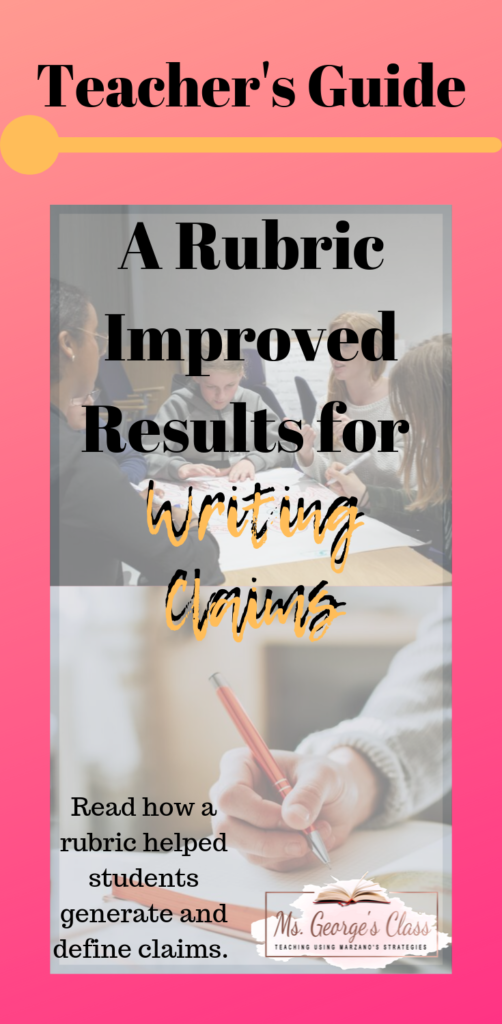
“Are we going to finish the read, write, discuss paper?” One of my students asked. I was totally astonished. I answered with a confident, “yes.” During a Teacher Based Team meeting, the English department was instructed to do a pre-assessment and post-assessment with one class. Teachers had to choose one standard, skill, and strategy to complete. The class I decided to evaluate was my reading lab class. The class has 14 students, six are in the 7th grade and eight are in the 8th grade. My standard was common core standard writing 7.1 “Write arguments to support claims with clear reasons and relevant evidence.” The skill and the strategy were, students will respond to the article: A Challenge for Everyone using the “Read, Write, Discuss, and Revise” strategy. We had two weeks to complete the assignment, but many of the teachers, including myself were in the middle of a lesson or had to complete a district-wide MAP testing. Time was pressing, but I was able to get the data to the meeting on time.
Pre-Assessment Lesson
The pre-assessment was to be a blind assessment without any teacher’s help. On Friday, I gave the students an article: A Challenge for Everyone to read by themselves. The article is about a middle school student speaking against a large, food plant that has contaminated the local water through pesticides. I distributed a teacher-designed read, write, discuss, and revise worksheet to the students. Students had to answer the essential question: “Does the government fairly takes into consideration everyone’s rights?” The pre-assessment scores were not very good. Out of eleven students, five students passed with 70% and the other six scored below 70%.

The Lesson Before the Post-Assessment
I decided for the post-assessment, I would perform a read- aloud strategy, vocabulary strategy, provide a rubric, and sentence starters. I taught the strategies on Tuesday and Wednesday. On Tuesday, I placed the article under the digital camera and read aloud the passage while annotating it. I made comments aloud, I underlined main points, and circled new words. Afterward, I posted the challenging words under the digital camera. Wednesday, we reviewed the challenging words and I distributed a sentence starter worksheet from SpringBoard worktext and a rubric I retrieved from The New Art and Science of Teaching by Robert Marzano. The rubric is one of a 4.0 scale and assesses how to generate and defend claims. I passed out the read, write, discuss, and revise paper, but because time was pressing, students needed more time to think and write.

Timing is Everything
During the Thursday meeting, I had the data from Wednesday’s lesson. Most of the students had one sentence and it was not a claim. Many of the students wrote a summary, which is a high-yielding strategy; but I wanted a claim, counterclaim, and supporting details. This time, out of 13 students, nine students earned 70%, while four students less than 70%. Each teacher had to state a strength and weakness. My strengths were the sentence starters and rubric, while my weakness was limited time. I asked for an extension and I was granted more time.
The Post-Assessments Improved Results
At the beginning of Thursday’s class, students asked to finish the read, write, discuss, and revise paper (RWDR). I gave each student a new sheet and gave them time to work on their assignment. I placed the sentence starter worksheet under the digital camera and allowed students to work independently. I was truly surprised when I received the new RWDR papers. Students wrote paragraphs about the essential question. They used “I agreed with the government because…” and they had textual evidence. Out of 13 students, 10 earned 90%-70%, and three earned less than 70%. Unfortunately, most of them missed the counterclaim, but it is a movement towards the right direction. I thought the work they gave to me on Wednesday was their best work, but they really put their best effort in their work on Thursday.

I felt proud while I read the student’s second post-assessment. The students took a difficult task and answered it correctly. I believe the think aloud, vocabulary development, sentence starters, and rubric helped students focus on the learning goal. I read the 4.0 scale rubric aloud and told the students that 4.0 is like earning an A in a class. The sentence starters assisted students to get started taking a stand on the subject. I enforced being passionate about agreeing or disagreeing on the topic. The students chose a side and used textual evidence to support it. Next time, I want the students to work on counterclaim development. I plan to have the students use adverb phrases such as “although”, “in contrast”, “however”, etc. The rubric and sentence starters are now part of my curriculum because I saw positive results when I used them.
What strategies do you use when teaching a complex text? Tell me in the comment section below.




Leave a Reply